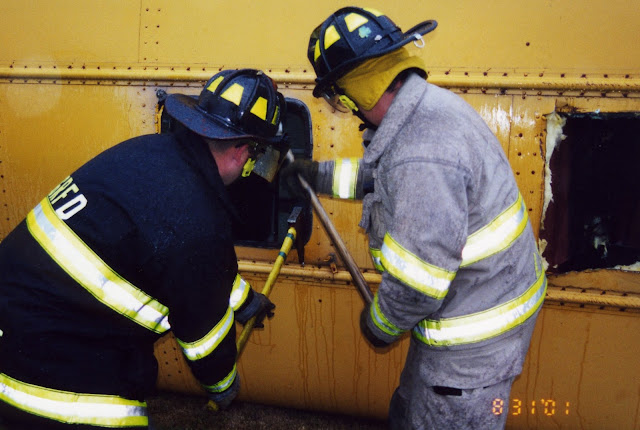 |
| Bus on the side is rare and challenging. Injuries are almost certain. |
Using existing openings will work well if patients can walk or have limited injuries and is the fastest and easiest to accomplish. In the pictured here, the bus is turned on the passenger side, rendering the passenger door, side and window exits unusable. In this scenario your best choice may be to use the rear door exit. Removal of the front windshield may also facilitate movement out via the front of the bus.
When existing opening aren't enough, enlarging existing openings is your next step. Enlarging openings such as roof hatches takes some time, personnel and equipment, but allows for rapid movement of rescuers and gear in and patients out. Once you start to cut on a bus be sure to reevaluate the need for structural stability and any effect on vehicle stabilization.
 |
| Firefighters use hand tools to augment power tools in this evolution |
Above: Two properly protected firefighters use hand tools to cut the roof outer skin. Its important to rely on hand tools as a back up to hydraulic or battery powered cutting tools. Hand tools can also be affective for arming multiple teams when power tools are in short supply.
Below: The roof hatch opening enlarged (hatch removed) to facilitate movement of a backboard or rescue basket and personnel in and out of the bus. Note the jagged sheet metal. These hazards must be covered. Sharp edges will be present in the interior of the bus as well as a result of cutting the interior skin.
 |
| Note the inner and outer skin and the presence of structural hoops |
Above: Marked by black arrow - Note the sharp edges on the outer skin (yellow) and the presence of the inner skin (red). Both will need to be removed and edges covered to prevent mechanical injury. FF John Harnischfeger (Ridge Road Fire District) points out a support hoop that has been cut to enlarge the opening. Hoop locations can be determined by the sequential line of rivets. Although these hoops can be cut, caution must be used as the structural integrity of the bus may be compromised.
Below: A triangle cut made towards the rear of the bus facilitates interior extrication/disentanglement and removal. Caution must be taken to remove any victims from that area prior to beginning cutting operations. Note the intact roof hatch to the right.
 |
| Gaining access no matter what side the roof is on. |
Up Next: School Bus - Exit at the Rear of the Bus

No comments:
Post a Comment
Note: Only a member of this blog may post a comment.